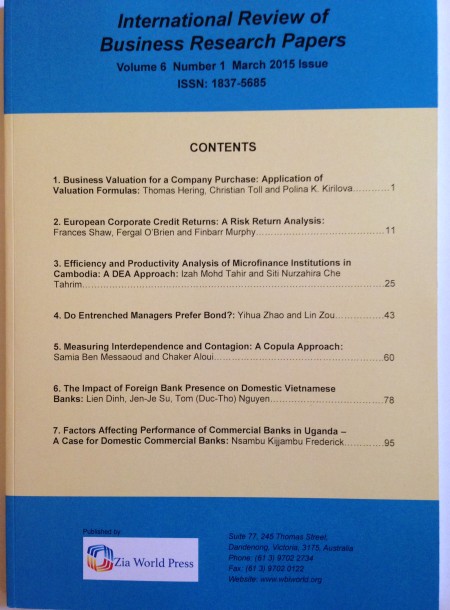Efficiency and Productivity Analysis of Microfinance Institutions in Cambodia: A DEA Approach

International Review of Business Research Papers
Vol. 11. No. 1. , March 2015, Pages: 25 – 42Efficiency and Productivity Analysis of Microfinance Institutions in Cambodia: A DEA Approach
This paper employs the non-parametric Data Envelopment Approach (DEA) and Dynamic Malmquist Productivity Index (MPI) to examine the efficiency and productivity of Cambodian microfinance institutions during the period 2008-2011. We found that the microfinance institutions in Cambodia have exhibited an overall efficiency of 92% during 2008-2011 suggesting an input waste of 8%. The overall efficiency has improved slightly from 91% in 2008 to 92% in 2009 and remained stable in 2010 and 2011. In addition, the results suggest that the MFIs in Cambodia have exhibited productivity growth of 1.7% during the period 2008-2009, a regress of 0.6% during 2009-2010 and a positive change of 0.9% in 2010-2011. Technological Change had been consistently influencing the productivity change during the period of study. The growth in the productivity of the MFIs in Cambodia in 2008-2009 was mainly attributed to the growth in Technological Change of 1.4%. In 2009-2010, the decline is also attributed to the decrease in Technological Change of 1.5%. Similarly, the increase in 2010-2011, is also attributed to the positive change of 1.5% in Technological Change. When decomposing the Efficiency change into Pure Technical and Scale Efficiency Change, results from both DEA and MPI advocate that the dominant source of efficiency was scale related rather than pure technically related. This implies that MFIs have been operating at an appropriate scale of operations but relatively inefficient in managing their assets and operating costs.Field of Research: Efficiency; DEA; Malmquist Productivity Index; Microfinance Institutions, Cambodia
